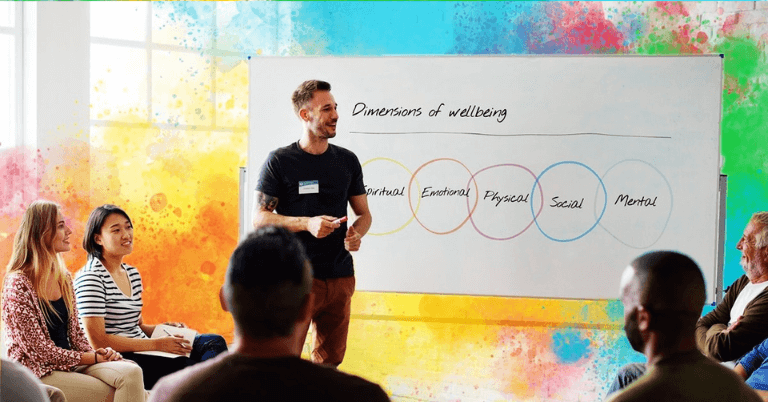Building a Workplace Wellness Program

Key Takeaways
- Wellness includes physical health, mental well-being, and more.
- Effective workplace wellness initiatives increase teamwork and morale, decrease stress and burnout, and positively impact performance.
- Involve your employees in designing a corporate wellness program and ensuring it evolves with employees’ needs.
The last few years have seen great evolution in the world of work. On the heels of unprecedented change due to the COVID-19 pandemic, individuals developed new day-to-day priorities. They reassessed their futures and their career paths, and generated demand for a completely new kind of workplace.
The Great Resignation kicked off in 2022. It was a historic moment in which millions were quitting their jobs to start something new. People craved the more human aspects of work. They sought purpose and balance.
Then, the phenomenon of Quiet Quitting rose to the forefront of workplace trends as individuals experienced intense post-pandemic burnout and sought to embrace a stronger balance between work and personal life.
All in all, these workplace trends showed that standard workplace practices aren’t cutting it anymore. Work mantras like “Work hard, play hard” and “Pay your dues and climb the corporate ladder” no longer resonate with people. Employees want opportunities for connection and advancement. They want work/life balance and purpose-driven projects. They want to feel fulfilled and supported.
Amid new employee attitudes, workplaces have had to adapt. One change that came in many organizations in response to these new attitudes was a renewed emphasis on workplace wellness.
What is workplace wellness?
You might ask yourself, what exactly are we talking about when we say, “wellness?” The Berkeley Well-Being Institute describes how wellness is a fusion of physical health and other dimensions of health that help us to feel safe and successful.
“Usually when people are referring to ‘health,’ they mean physical health, and when people say ‘well-being,’ they are referring to mental health. Wellness is a somewhat broader term that generally includes both physical health and mental well-being as well as other dimensions like spirituality.”
Workplace wellness initiatives, or programs designed to help improve all-around employee well-being, have been on the rise in the post-pandemic workforce. Successful programs are seeing positive results.
Why is workplace wellness important?
In a Wiley Workplace Intelligence survey, 46.9 percent of all respondents and 50.5 percent of respondents with direct reports said that a focus on employee wellness has positively impacted performance. People managers are noticing that when companies invest in workplace wellness, employees are more productive, more engaged, actively taking on new projects, and achieving better performance ratings.
Corporate Wellness Magazine notes that workplace wellness initiatives come with a host of other benefits for the company as a whole, including:
- Better teamwork and collaboration
- Less stress, sleep deprivation, and burnout –This reduces the risk of other day-to-day hazards, such as illness and road accidents
- Healthier employees, and fewer people being out on sick leave
- Stronger trust in and respect for the company from employees
- Improved team morale
- Stronger talent acquisition and retention
Crafting a successful workplace wellness program
What steps do I take?
The CDC’s Workplace Health Resource Center notes that three basic steps can help employers create an engaging workplace wellness program. These steps ensure that your program includes insights from your employees and has a measurable impact.
- Design and analyze: Seek employees’ input. Assess their interest in participating!
- Implement: Build your program: provide free or low-cost program options and communicate these to employees through relevant channels.
- Evaluate success: Collect participation data, employee feedback, and success/impact stories. Then, rebuild parts of your program that aren’t garnering participation or enjoyment from employees.
At DiSCprofile.com, we have some ideas and tips for each step of this framework.
Designing your program
Knowing where to start when building a corporate wellness program can be difficult. Workplace wellness programs aren’t as simple as offering healthier options in the company cafeteria. While physical wellness and quality nutrition are definitely part of a workplace wellness initiative, there are many other areas of wellness that also require attention in the workplace. In fact, The Berkeley Well-Being Institute identifies eight dimensions of wellness:
- Emotional wellness
- Environmental wellness
- Physical wellness
- Intellectual wellness
- Occupational wellness
- Social wellness
- Financial wellness
- Spiritual wellness
These are all key areas to consider when building a workplace wellness program.
It’s tempting to try and tackle all of these at once, but building a workplace wellness program takes time.
A great way to start is by surveying your employees. Ask them directly about what wellness areas they want to see prioritized. You can use this data to set wellness objectives and build small parts of your overall wellness program designed to meet those objectives.
For example, you might survey your people and find that there’s a looming culture of stress in the workplace. As a result, you might identify the following objective:
Reduce company stress culture by introducing mindfulness and meditation concepts.
By breaking down your wellness program into smaller, objective-based initiatives, you can begin to intentionally incorporate multiple dimensions of wellness. It ensures that data from your employees stays at the forefront of your efforts!

Implement your program
Given the different types of wellness, there are a number of initiatives you could start with when implementing a new wellness program. Here are some ideas.
Cultivate a culture of psychological safety
Amy Edmundson’s concept of psychological safety centers on how individuals think they’re perceived in their workplaces. It is the belief that you won’t be ostracized or punished for voicing concerns and opinions, sharing ideas, and making mistakes. A sense of psychological safety could have a tremendous impact on emotional wellness.
Trust and psychological safety can improve teamwork and workplace culture. They ensure that teams are more likely to share ideas, reveal and discuss mistakes, ask for and receive feedback, take reasonable risks, and confront work-life issues.
Interpersonal learning
A wellness program devoted to psychological safety could include a variety of activities and workshops. Everything DiSC assessments are one tool you could utilize. DiSC sessions help teams get to know one another better, and give coworkers more insights into each other's workplace motivators, stressors, and preferences. This practice of interpersonal learning is the best way to create an environment of psychological safety on teams, as it creates a mutual understanding around what employees want and need from their work environment.
Town hall meetings
Additionally, routine “town hall” meetings where employees can communicate directly with upper-level management could be a great component of a workplace wellness program focused on psychological safety. In a 2022 Wiley Workplace Research study, “listening sessions with leaders” was one of the five policies correlated to lower employee stress. These meetings give managers the opportunity to respond and have an open dialogue with employees. Doing this regularly can remove the fear of punishment or embarrassment that often comes with voicing concerns to higher-ups.
Introduce a wellness challenge
Workplace wellness challenges are a fun way to build community, and get employees engaged with different dimensions of wellness! Technology has made it easier than ever to build one of these challenges, whether your team works in person or fully remotely.
TIP: When building wellness challenges, DiSC assessments are your secret weapon. Using the “Your Colleagues” section on Catalyst™, you can view your colleagues’ motivators. Maybe public recognition is their thing. Maybe it’s the promise of a reward. Maybe it’s a private note of recognition, or the opportunity to collaborate with others. You can take information about employees’ workplace motivators and build a variety of challenges and incentives that appeal to all of them.
1. Fitness challenges
Consider launching a challenge to promote physical wellness! Using activity tracking apps like Strava, you can create group challenges for activities like walking and running. You can have employees participate as individuals or as teams, and add prizes for your top teams to up the stakes!
You can also host virtual or in-person fitness classes, and challenge employees to attend. From strength training to yoga, you can find an instructor to host a class and challenge employees to try it. Consider giving shoutouts to attendees via your internal communication channels or offering a prize like a group lunch to the team with the highest number of class attendees.
2. Sustainability challenges
Try creating a sustainability challenge to promote environmental wellness. There are several ways you can encourage teams and individuals alike to be more sustainable in their daily lives:
- Sending reminders to recycle scrap paper and waste
- Providing compost bins onsite or for employees to take home
- Creating "Meatless Mondays," which encourage more sustainable eating
- Reducing the use of single-use plastics in office spaces
Challenge employees to commit to helping the planet in their day-to-day lives to improve workplace wellness and help the planet!
3. Community service challenges
Companies can encourage employees to participate in community service initiatives. HelpGuide explains that participating in community service can help people:
- Connect with their teammates
- Build relationships with new people from their communities outside of work
- Learn new skills
- Improve their mental wellbeing
- Create a sense of fulfillment
Challenging individuals or teams to participate in community service can bring on all of these benefits and make your organization a positive force in its community. Some companies even offer employees 1-2 community service days per year, on which they can take the day off work and volunteer in their communities.
Build a culture of reaching out
Checking in with others
To promote mental, social, and occupational wellness, it’s important to create a culture in which employees reach out to coworkers who may be struggling. No one wants to feel left alone with their problems and stressors. Talking about these things in the workplace helps to strengthen bonds between coworkers and helps teams know when to redistribute workloads in order to prevent burnout.
A blog post from Daily Dose Wellness, a corporate wellness consulting company, provides advice for noticing when your coworkers might be having a difficult time at work, and asking intentional questions to help them open up.
For example, instead of asking an open-ended question like “How are you?”, you can try leading with vulnerability on your end, and say something like, “I’ve been feeling x, have you been feeling that way too?” This can help your coworker feel more comfortable opening up.
In addition to this, employees should be encouraged to notice when their teammates might need a hand. They should be on the lookout for key behavioral changes, as those can be signs that employees aren’t feeling their best.
For example, let's say a coworker is less engaged in conversation than they normally are. To check in on a situation like this, you could say something like, “Hey, I haven’t heard much from you in our team group chat. Do you want to catch up over coffee sometime?” This shows that you see and care about what your coworkers are going through and gives you the time and space to reconnect with them.
This culture of reaching out can help employees maintain a sense of connectedness at work and give them the platform to seek support from their teammates.
Expressing gratitude
Workplace wellness is also improved when employees express and receive gratitude. The practice of giving and receiving words of encouragement has positive psychological effects and can help employees feel a heightened sense of purpose and confidence. A wellness program that normalizes sending words of gratitude could have a positive impact on employee morale.
So, what can you do from a programmatic standpoint to help build a culture of reaching out? There are a number of options depending on what motivates your people.
Host an in-person or virtual workshop on how to reach out to and help coworkers who might be struggling at work. Encourage your managers to discuss the importance of reaching out to teammates in individual and team meetings. Encourage them to model that behavior as well! Invest in a technology tool that helps teams express gratitude for one another, like a virtual gifting platform or a thank you note integration for your existing internal messaging platform.
If there’s one thing the COVID-19 pandemic taught us, it’s that people are getting super creative about staying connected. When you take advantage of the tools that are out there, the possibilities are truly endless!
Host workshops and events
Social well-being is important in the workplace, especially for those i-style and S-style individuals who value connection and collaboration. Events and workshops can help bolster social well-being while approaching other wellness topics.
Here are some ideas for topics and guests you can use for inspiration:
- A financial planning workshop that helps employees develop stronger financial literacy and wellness
- A workshop on meditation and mindfulness practices that helps employees cope with workplace stress
- Group meetings or one-on-one sessions with the company's benefits team about what health and wellness resources are available via their benefits packages, and how to use them
- A session on how to organize your workspace to create harmony and productivity
- Group fitness classes during or after the workday – Consider partnering with local gyms or fitness studios to get your employees discounted rates so they can work out affordably and on their own schedule
All of these events give employees the opportunity to connect with each other while focusing on a new element of wellness.
Try to ensure that there are resources that attendees can use on an ongoing basis after the workshop to deepen their learning, such as websites, videos, follow-up sessions, and employee interest groups and committees.
Have professional or life coaching resources available for when employees feel stuck
Employers have seen an uptick in demand for occupational wellness initiatives, or programs that help employees propel their career growth and increase career satisfaction. In order to meet these demands, organizations should have the goal of helping their employees develop new skills and grow to new career heights during their tenure.
Employers can do this by making professional and life coaching resources available to employees. Sometimes, it’s helpful to get advice from a trained coach who is familiar with your field and potential avenues for growth.
Coaches can help employees set goals and create steps that will help them reach those goals. They prevent employees from feeling stagnant or bored with their work and help them identify new challenges they may want to take on.
In addition to this, the International Coaching Federation reports that a company culture that embraces coaching is correlated with higher company performance. They can help take your workplace wellness programs to the next level on a more individual level.

Expand benefits
While workshops, events, and coaching sessions can be helpful, sometimes the most impactful way to impact workplace wellness is by expanding your company's benefits offerings.
There are multiple platforms and tools that companies are utilizing to expand their employees' access to mental and physical healthcare. Your organization may want to explore:
- Getting company-wide access to a meditation app like Headspace or Calm
- Including telemedicine platforms for virtual mental health or medical care in your benefits packages
- Giving your employees a monthly allotment of credits on a fitness class booking platform like ClassPass
- Sparking intellectual curiosity and growth by giving employees access to LinkedIn learning, or higher education assistance programs
Investing in the expansion of your benefits can help your employees engage with all of the dimensions of workplace wellness on their own time. This also reassures employees that companies truly care about their well-being and are willing to go the extra mile to keep them as healthy and happy as possible.
Create a workplace wellness committee
Creating an employee-led wellness committee can help your company maintain an ongoing commitment to workplace wellness. Ideally, a committee like this would be volunteer based so that employees with a special interest in wellness could get more involved.
Employee-led committees can help budget makers get a sense of the kinds of wellness initiatives people really want. They can also generate excitement about the programs with their peers, promoting engagement with the activities and benefits offered. The committee can act as ambassadors who help your workplace remain enthused about and committed to wellness at work.
Promote your wellness program
There are a number of ways that workplace wellness programs can be successfully promoted.
- Regular internal newsletters that include reminders about events/challenges, wellness tips and tricks, and announcements about changes to the program are a great way to keep employees engaged and in the know.
- A wellness-centered intranet or SharePoint site full of resources and event information could help employees by giving them a collection of resources they can refer back to all the time.
- Managers should make announcements about wellness programming in their team meetings and one-on-ones. Managers can take this one step further by actually going to the events and utilizing wellness programming themselves! This helps to get the word out while ensuring that employees know that they can and should engage with wellness programs. It shows employees that taking time out of the day to attend workshops or participate in challenges is encouraged!
Evaluate success
After implementing a new employee wellness program, it’s important to evaluate the success of the program and determine if there are other areas where your wellness time and budget could produce more of an impact.
This is another stage of the program-building process where it would be helpful to send a survey to your organization to gather data on what parts of the program are working and what parts could improve. Gathering feedback and tweaking your wellness programming based on that feedback will encourage employees to engage with it. The process demonstrates that the program is built specifically for them in accordance with their needs.
You should also keep track of participation and engagement as you implement your wellness program.
- Is attendance high at wellness workshops?
- Are people making use of the wellness-centered group chats you created?
- Are there consistent numbers of participants in new wellness challenges?
Compile this data and learn which programs are most popular.
Once you process this kind of data, you can continue to change and scale your wellness program based on employee demand.
How DiSC® can inform your workplace wellness program
Keeping your people at the center of your workplace wellness programs is key, and the only way to do that is by learning more about them. As mentioned before, a company-wide survey is a great way to discover your employees’ wellness interests and prioritize which initiatives you’ll start with. You’ll also want to gather information about their personalities, motivators, and stressors in order to generate buy-in.
Enter Everything DiSC®—the personality assessment that generates insights into employees’ workplace preferences. Everything DiSC Workplace® assessment-takers receive 20-page reports about their DiSC styles and their workplace preferences and stressors. These reports also offer guidance around the kinds of tasks that energize respondents, and what tasks take a bit of extra effort. You can get a high-level view of your company’s DiSC data by running a group report, which will show you the distribution of styles.
You can also get insights about your people using Catalyst™, Everything DiSC’s interactive learning platform. In the “Your Groups” section, you can view different groups of your colleagues and discover what their DiSC styles are. Using the “Group Continua” feature, you can also view where they fall on different behavioral continua and uncover the range of preferences that exist on your teams.
Incorporating DiSC assessments can help strengthen your professional wellness program by adding another layer of customization. By knowing more about the people you’re building the program for, you can create activities and rewards that appeal to everyone.
For example, you may see in your group report that you have a lot of i-style individuals in your organization who love to socialize. They’re motivated by interpersonal connection and enthusiasm. At the same time, you might notice that you have a high percentage of C-style employees who love their routines and are stressed out by too much time spent off-task. As a result, you may want to build a program that contains both immersive social activities and workshops, and options that allow employees to take what they need, such as virtual webinars and meditation app subscriptions. Including activities and benefits that appeal to a wide range of personalities is important, and DiSC allows you to see what options will appeal to your people.
Looking at the DiSC styles that exist across your organization is a great way to gather some data on what your people might want from a wellness program. After you collect your data and begin planning, it’s time to build out your program!
Conclusion
The demand for employee wellness initiatives is growing, but it’s important to remember that these programs don’t build themselves overnight. In order to prevent overwhelm, focus on one thing at a time. Start by learning about your people. Then, build out a few starter initiatives based on that. Eventually, you'll also want to evaluate their success and scale.
Remember that every small step toward a more robust workplace wellness program is a step in the right direction! A step towards employee satisfaction and engagement, feelings of comfort and safety, and an environment that is happier and healthier.
Posted 01/14/2025







